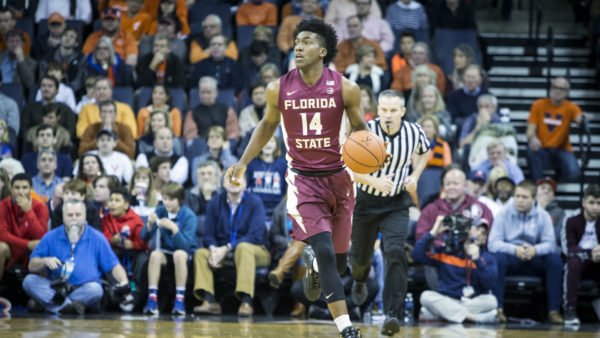On Florida State: It May Not Be A Down Year After All
Posted by Brad Jenkins (@bradjenk) on December 14th, 2017Last season was one of the best in Florida State basketball history — the Seminoles won 26 games, finished tied for second place in the ACC, and earned a #3 seed in the NCAA Tournament. Given the losses of his three best players from that squad (Dwayne Bacon, Jonathan Isaac, and Xavier Rathan-Mayes), however, head coach Leonard Hamilton was not expected to keep Florida State among the league’s elite. Yet here we are in mid-December and the Seminoles are 9-0 and ranked 19th in the latest AP poll. Their schedule has not been very challenging to date (ranked 283rd nationally, according to KenPom), but Florida State has been pounding the teams it is supposed to beat and also owns a big road win at Florida. So are the Seminoles for real?

Terance Mann leads a balanced Florida State attack this year. (Getty Images)
Hamilton prefers to spread out his playing time more than most coaches, and last season was a great example of that. Eleven Seminoles averaged double-figure minutes with the top three seeing over 25 minutes per game. This year’s squad is not quite as deep but it has a more balanced scoring attack. Four Florida State players averaged more than 5.5 points per game last year but this version has seven scoring over 7.0 points per outing. Hamilton likes his team’s balance and unselfishness, saying recently, “They’ve bought into the idea that we need each other in order to be successful. We don’t have anybody that feels like they have to carry us. Everybody feels like they have to carry their part.”
Leading the way is versatile wing Terance Mann (15.6 PPG, 5.6 RPG, 2.8 APG), who is having a breakout junior season (just as we projected). He has a lot of help on the perimeter in sophomore point guard C.J. Walker (11.2 PPG, 3.2 APG, 17 steals) and former JuCo transfer Braian Angola and freshman M.J. Walker — both of whom are connecting on over 42 percent of their three-pointers. Sophomore Trent Forrest also provides a little bit of everything, from scoring (7.1 PPG) to rebounding (4.9 RPG) to passing (3.6 APG) and defense (15 steals). Up front, Hamilton is getting good production from two players who barely contributed in 2016-17. Senior Phil Cofer has shown flashes of talent throughout an injury-filled career, but a healthy first quarter of this season is allowing him to produce in the paint (12.3 PPG, 5.8 RPG). Redshirt freshman Mfiondu Kabengele has also been a pleasant surprise, averaging 9.0 points and 5.0 rebounds in only 14.3 minutes per game. Florida State’s historical tendency to feature shot-blocking seven-footers is no different this year. Freshman Ike Obiagu is swatting 20.4 percent of opponents’ two-point attempts when he plays, and Hamilton is hoping to get another strong rim-protector in the form of 7’4″ Christ Koumadje back from a foot injury in time for ACC play.
Six different Seminoles have been the team-high scorer over Florida State’s first nine games, but it remains to be seen if that balance of offense will become a negative when conference play heats up. Defensively, Hamilton’s team seems willing to allow offensive rebounds (291st nationally in defensive rebounding percentage) as a trade-off for trying to block or alter as many shots as possible. That strategy will be put to the test when the Seminoles open ACC play against Duke — the nation’s top offensive rebounding team — on December 30. Next up for Florida State is a semi-neutral meeting with Oklahoma State in Sunrise, Florida, this Saturday (2:00 PM ET). If they can win that game, look for the Seminoles to be sitting at 12-0 headed to Durham with a legitimate chance to prove they still belong among the big boys in the ACC.










































